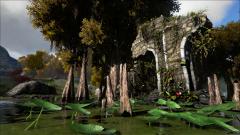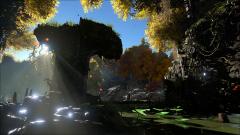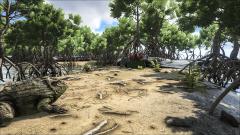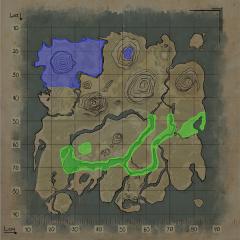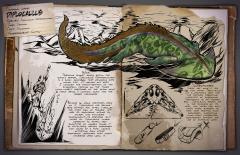Search the Community
Showing results for tags 'swamp'.
-

Irritator Challengiri: The Most annoying predator to ever live
maposuar posted a suggestion in Creature submission archive
Features: This creature is, how should I say this? It's the de facto apex of the swamps only weaker than the spino (at least in the swamp).It is only a bit easier to find than the spino. Being high up in the food chain as a predator, you would expect it to be aggressive right? But no, when it sees other dinosaurs it taunts them, due to it's irritative nature. It can make anything that sees it go into a blind rage by using it's taunting attack. When in water, it can use a stun attack like it's relative the baryonyx, but the irritator's stun effect is longer. When a tamed irritator uses the taunt attack with other tamed dinos in front of it, the dinos get 55% Damage boost, but they don't listen to their owner's commands. The "rage" it inflicts isn't like gigas rage, the raged dinos won't attack their owners' and allied dinos, but the rage attack increases a giga's real rage bar. And to make it true to what I advertised in the title, it will ambush you, like always. Literally always. And wild irritators can grab you and unrideable dinos and drag it's grabbed prey into the water to get stunlocked. It is also the ultimate escape mount, as anything taunted by it doesn't see properly and is easily distracted, so youe can make a quick getaway. Inspirations: I saw the trend of the of the spinosaurids in ark having a land based equivalent: Spino-Rex Bary-Allo So I thought: "Why not make a yutyrannus equivalent"? And the irritator was born. At least to me. -

Koolasuchus titanic, the last Temnospondyl
cart400 posted a suggestion in Creature submission archive
Koolasuchus cleeland was a giant Temnospondyl that lived in the Cretaceous period in Australia and Antarctica, and now I will talk about the subspecies created by me. Wild: The Koolasuchus titanic is found in swamps with its incredible 10 meters long and 2 meters high you don't want a fight with one of these brutes, if a Sarcosuchus holding you in its jaws is a problem, Koolasuchus will make it worse it is an ambush predator its colors camouflage it in the murky water of the swamp and if a creature smaller than the raptor passes and it attacks it will be swallowed in the same moment, being incredibly fast in the water and with the strength comparable to that of a spinosaurus he is practically the king of the swamps where his tail stuns the enemies and his gigantic jaw cuts the flesh of the enemies Taming method: To have Koolasuchus as your companion you will have to hunt blood from leeches in the swamp, after getting all the blood you need wear camouflage clothing and get close to Koolasuchus while he rests and throw that blood so he will feed and start the taming process where you will have to take him away from the swamp and start a battle with him (note: you will have to fight alone) and if you leave him with 25% of life he surrenders and sees you as a leader. Skills: Tail Attack: An attack where he turns around, attacking with a tail on land, and spinning in a circle in the water. Choking Bite: It launches in, dealing 300% more damage to creatures smaller than a raptor and fair damage to larger creatures. Mucus Release: Koolasuchus has the ability to produce a mucus in its body that is harmful to other creatures leaving them confused, it can gather this mucus in its mouth and release it in the form of a ball which would trap creatures smaller than a parasaurolophos. Liabilities: Immunity to amber: As an amphibian it has smooth skin and releases a kind of mucus that makes it immune to amber released by rhyniognatha. Saddleless: Koolasuchus as well as diplocaulus do not enjoy a saddle as their mucus is sticky and is not harmful to humans. Mucus Armor: As you can see Koolasuchus' mucus has many abilities and since it doesn't seal mucus when produced by a domestic Koolasuchus it has the ability to reduce 30% of damage directed at Koolasuchus. Dossier: The Koolasuchus is a spectacular amphibian that lives in the lakes of this place this great predator of the swamps can be formidable in its attacks but a cute companion for your home its playful way when tamed is a notable point but when it comes to battles this amphibian is comparable to a spinosaurus many tribes use it as mucus turrets to trap possible opponents in addition to doing Koolasuchus battles with them assuming a crooked posture when they battle for territory with another of the same species looking like a sumo battle it's amazing to see this battle.-
- rhyniognatha counter
- giant amphibian
- (and 7 more)
-

Anatosaurus hiruphagus, the Fever Deleter
Serpent1cular posted a suggestion in Creature submission archive
Good afternoon, survivors! After being stumped on what to do for this contest, me and a fellow 'Retrosaur' loving friend have imagined the perfect counter to that pesky airborne virus that plagues the safe zones of every map.. May I present the wonderful, splendid looking and immaculately moisturized hadrosaur.. THE ANATOSAURUS! The Hadrosaurs are a family of dinosaurs that I hold close to my heart, and as an enjoyer of older depictions of these animals I thought that ARK could really do with another duckbill in its roster - and especially one with a twist like this.. Dossier Common Name: Anatosaurus Species: Anatosaurus hiruphagus Time: Late Cretaceous Diet: Omnivore Temperament: Neutral (Aggressive towards bug repellant) Wild An oddity amongst its relatives ornithopods. They are native to the steamy swamps of The Center’s ring and possess an amphibious lifestyle, spending their days happily grazing upon aquatic vegetation and occasionally dousing their slimy bodies in mud to protect against the harsh sun. Coincidentally this behavior also acts as a form of medication, covering over open wounds and cleaning them of debris. This however is largely irrelevant, as at full maturity an Anatosaurus is too large to fall prey to predators with the exception of a lucky Sarcosuchus. Herds of Anatosaurus will often slumber peacefully upon riverbanks, their unique odor attracting droves of flies and other nasty insects. It is to be noted however that whilst a predominantly herbivorous creature an Anatosaur will never pass down an opportunity to devour its favourite treat, leeches - a craving that swamp dwelling survivors have learned to use in their favor. Domesticated Due to their apparent disdain of bug-repelling gel, the act of taming an Anatosaurus is one fit for only the most daring of survivors. These strengthened few have been documented allowing leeches to suck onto them and then wading around until one of the hadrosaurs is drawn to the scent. With one of the parasites latched onto their body the survivor will find soon themselves in the clutches of a hungry hadrosaur, eager to lap down their offering. It is a lengthy process, but by no means is it worthless. Once tamed, Anatosaurus can make for robust beasts of burden within the territory of a developing tribe. Their use as a mount both above and below the water allows them to be utilized in a variety of tasks, namely aqueous foraging and exploration. Whilst not impeccably fast nor strong the hadrosaurs are capable of dealing with a variety of threats by either being steered by their jockey to fight, or to simply flee into the nearest lake or river and make an escape. However the most notable service an Anatosaurus can provide is, oddly enough, its viscous saliva, the production of which can be manipulated upon the animal's consumption of silica pearls. This fluid can, in moderation, be used as a stand in for leech blood in the production of the lesser antidote - an item of high demand in populous areas. Due to the potential obscurity of the ingame dossier, I feel it is best to formally chronicle Anatosaurus' taming method and usage here. TAMING Not unlike recent additions to the game the method of taming an Anatosaurus is quite different than your standard "knock-out-and -feed" creature. The way the player goes about obtaining this buffalo-like beast is quite engaging, as it requires a fairly coordinated plan as to not perish in the swamp's murky waters. Anatosaurus is by default a neutral creature, however in the presence of a player wearing bug repellant it will quickly grow to become hostile. This is because in order to gain its trust, you must feed the hadrosaur its favourite treat - the disgusting leeches - and to do so you must let the parasites latch onto you. With a leech (or multiple) on you, any Anatosaurus within a certain vicinity will grow attracted and make their way over. They will then reach forward and pick up the player and pluck the leech(es) off of you, before dropping you to the ground and carrying on. The more leeches on you, the more the taming bar increases, and proportionally as does the cooldown between feedings. Similar to other passive tames if the hadrosaur happens to take any creature or player induced damage then the bar will reset, however their large size does make it so that usual swamp life such as Titanoboa and Kaprosuchus rarely bother going after them. They will be attracted to you, though.. STATISTICS Since it is ultimately the devs' decision in case I hit a stroke of luck and get voted through I will not be going over specifics in stats for the Anatosaurus. I will provide a rough estimation made by my friend for it's base stats and spawn rates however, but take this with a grain of salt. (Stats at Level 1) Health - 500 Stamina - 200 Oxygen - 400 Food - 2500 Weight - 300 (Spawns) Only in swamps with a rate of 1 every 40 minutes. Doesn't get targetted by swamp animals with the exception of Sarcos but will be attacked by other non-swamp life upon getting close to them. USAGE Anato is all around a fairly decent mount that will serve a middle game tribe quite well in the exploration department. Its running speed is slightly slower than fellow ornithopod Iguanodon, however it burns through stamina much quicker. In the water however the Anatosaurus is capable of swimming around as fast as the Baryonyx, and its stamina consumption is decreased immensely. As for combat, it is the epitome of average. If need be an Anato can defend itself from smaller threats and is by no means defenseless, but when it comes to a pack of Allos or other larger theropod it is best to steer clear. It is because of this reason that it is advisable to stick within a brisk sprint to a water source to make an escape if nescessary. Anato would also possess two mouse abilities; a simple arm swipe tied to LMB, and a pick up for RMB. Now, onto Anatosaurus' main three abilities; the serendipitous slobber, carrying and its skin care rituals. MUD BATH Being an amphibious creature it made sense to give this Anato the ability to coat itself in wet sediment to give itself the aptly named 'Mud' buff. Preferably requiring you to be standing on ground close to water, an Anatosaurus can be whistled to give itself a luxurious dousing of mud that will temporarily grant it a 50% resistance to bleed as well as increased healing. The buff will last around 5 minutes at most and have a 10 minute cooldown in order to even it out. This ability will give it just that little bit more protection out in the field, plus you cannot lie that it fits the whole rompin' stompin' aura that this hadrosaur emits. When mounted this ability can be activated with at default the C key, and will grant the player a temporary heat resistance buff - the perfect dino to cool down on a hot summers' day! One thing to be noted however is that this mud coating will wear off as soon as you enter water. This is to encourage land exploration with the buff active. ANTIDOTAL SALIVA Have you ever logged in to a server only to find the spawn zones plagued with beach bobs spreading Swamp Fever to every last person who enters? Ever wished that there was a way to make the tedious process that comes with making the antidote.. A little less so? Well, those days are no more with a tamed Anatosaurus in your tribe! Due to living in one of the most revolting places known to man the Anatosaurus has grown unbothered with the mere concept of infections, and its craving for leeches has made it immune to the nasty pathogens found in the parasites' systems. It is because of this that the hadrosaur is a living cure for the scourge of Swamp Fever. It's bodily fluids are revered by tribes due to their medicinal properties, and its saliva in particular, which can be harvested from a tamed Anato's inventory roughly 10 seconds after feeding it a proportional number of silica pearls, which is placed in the hotbar and fed with "E". The cooldown is short, about 30 seconds. It is to be noted that high level Anatos require more pearls whilst low levels require less, so fairly standard. This saliva can be used as a substitute for leech blood in the recipe of lesser antidote vials, making the Anatosaurus an impeccably useful tame even long after its days of exploration are over in an apex level tribe. CARRYING Tying in to its use as an exploration mount the Anatosaurus possesses the charming ability to pick up smaller creatures and even certain structures in its webbed hands and bring them along on your escapades! Of course there is a limit for both, with the largest creature able to be carried being the player, and for structures it is the small item box. This means that the Anato would be useful as a means to set up temporary camps along your routes, or even assist in the moving of small tames and storage from one base spot to another. Whilst (hopefully) self explanatory, I thought I'd disclose the fact that when holding an object/creature, the Anatosaurus will not be able to use its LMB swipe attack. THANK YOU FOR READING! I hope you like this unique take on a (relatively) obscure dinosaur! -
^All Art is done by Lapis Lazuli and Dossier is edited by Mihael Common Name :Majungasaurus Species : Majungasaurus absconditus Time : Late Cretaceous Diet : Carnivorous Temperament :Opportunistic WILD: Majungasaurus absconditus is quite the interesting theropod. While most of the creatures of the ark look different to their real life counterparts, majungasaurus seems to have evolved to fit into a new niche in the arks ecosystem. It seems to have adapted many traits from modern day chameleons including the ability to change their skin color to camouflage into their surroundings. Many survivors often talk about how they feel like there's something always watching them just from the treeline out of sight and from my studies I believe that majungasaurus may be the culprit. They seem to have a higher intelligence than most creatures on the ark and are very curious by nature. Domesticated: A tamed majungasaurus however is a scientist's best friend. These creatures can be used to sneak up on and study even the most dangerous of animals and can even help find certain desired traits in wild creatures. And for those who would rather venture out on their own, some survivors have figured out how to modify their armor with the shedded scales of majungasaurus to give them limited camouflage. Taming: To tame a majungasaurus you must gain its trust by crafting structures and other trinkets to appease its curiosity. The higher quality item the less taming effectiveness is lost. Taming 2: To tame a majungasaurus you must gain its trust by feeding into its cannibalistic tendencies. You must kill and bring other majungasaurus to the target majunga Stat Reading: While camouflaged on a majunga you are able to sneak up on unsuspecting creatures. If you're able to get close enough your majunga will be able to act like a primitive HLNA from the genesis maps and read out the base stats of said creature. Camouflage Armor: As the majunga sheds its skin, survivors will be able to gather leftover scales and apply it to their armor to gain the majungas ability to camouflage. However unlike majunga survivors will only be able to camouflage while standing completely still. Combat: The majunga isn't really much of a fighter so it only has a basic bite attack that does around the same damage as a carno. Size: The Majunga would be around the size of Megalosaurus ingame which would allow it to be a new caving creature since we haven't gotten anything capable of caving in a long time. Suggestions from Replies: Getting a buff when eating another Majunga Eat other tamed Majungas when it gets low on hunger Main Attack does bonus damage if used while invisible (brings majunga out of invisibility)
- 160 replies
-
- 4
-

-

-
- camoflauge
- stealth
-
(and 7 more)
Tagged with:
-

Anatosaurus hiruphagus - The Fever Deleter
Serpent1cular posted a suggestion in Creature submission archive
Good afternoon, survivors! After stumped on what to do for this contest, me and a fellow 'Retrosaur' loving friend have imagined the perfect counter to that pesky airborne virus that plagues the safe zones of every map.. May I present the wonderful, splendid looking and immaculately moisturized hadrosaur.. THE ANATOSAURUS! This is a concept of how I imagine the Anatosaurus to look like. Forum restrictions have butchered the quality though so apologies *A full dossier of the Anatosaurus is a work in progress* The Hadrosaurs are a family of dinosaurs that I hold close to my heart, and as an enjoyer of older depictions of these animals I thought that ARK could really do with another duckbill in its roster - and especially one with a twist like this.. Dossier Common Name: Anatosaurus Species: Anatosaurus hiruphagus Time: Late Cretaceous Diet: Omnivore Temperament: Neutral (Aggressive towards bug repellant) Wild: An oddity amongst its relatives the Anatosaurus behaves in a manner completely unlike ARK’s other ornithopods. They are native to the steamy swamps of Ragnarok’s southern quarter and possess an amphibious lifestyle, spending their days happily grazing upon aquatic vegetation and occasionally dousing their slimy bodies in mud to protect against the harsh sun. Coincidentally this behavior also acts as a form of medication, covering over open wounds and cleaning them of debris. This however is largely irrelevant, as at full maturity an Anatosaurus is too large to fall prey to predators with the exception of a lucky Sarcosuchus. Herds of Anatosaurus will often slumber peacefully upon riverbanks, their unique odor attracting droves of flies and other nasty insects. It is to be noted however that whilst a predominantly herbivorous creature an Anatosaur will never pass down an opportunity to devour its favourite treat, leeches - a craving that swamp dwelling survivors have learned to use in their favor. Domesticated: Due to their apparent disdain of bug-repelling gel, the act of taming an Anatosaurus is one fit for only the most daring of survivors. These strengthened few have been documented allowing leeches to suck onto them and then wading around until one of the hadrosaurs is drawn to the scent. With one of the parasites latched onto their body the survivor will find soon themselves in the clutches of a hungry hadrosaur, eager to lap down their offering. It is a lengthy process, but by no means is it worthless. Once tamed, Anatosaurus can make for robust beasts of burden within the territory of a developing tribe. Their use as a mount both above and below the water allows them to be utilized in a variety of tasks, namely aqueous foraging and exploration. Whilst not impeccably fast nor strong the hadrosaurs are capable of dealing with a variety of threats by either being steered by their jockey to fight, or to simply flee into the nearest lake or river and make an escape. However the most notable service an Anatosaurus can provide is, oddly enough, its viscous saliva, the production of which can be manipulated upon the animal's consumption of silica pearls. This fluid can, in moderation, be used as a stand in for leech blood in the production of the lesser antidote - an item of high demand in populous areas. Due to the potential obscurity of the ingame dossier, I feel it is best to formally chronicle Anatosaurus' taming method and usage here. TAMING Not unlike recent additions to the game the method of taming an Anatosaurus is quite different than your standard "knock-out-and -feed" creature. The way the player goes about obtaining this buffalo-like beast is quite engaging, as it requires a fairly coordinated plan as to not perish in the swamp's murky waters. Anatosaurus is by default a neutral creature, however in the presence of a player wearing bug repellant it will quickly grow to become hostile. This is because in order to gain its trust, you must feed the hadrosaur its favourite treat - the disgusting leeches - and to do so you must let the parasites latch onto you. With a leech (or multiple) on you, any Anatosaurus within a certain vicinity will grow attracted and make their way over. They will then reach forward and pick up the player and pluck the leech(es) off of you, before dropping you to the ground and carrying on. The more leeches on you, the more the taming bar increases, and proportionally as does the cooldown between feedings. Similar to other passive tames if the hadrosaur happens to take any creature or player induced damage then the bar will reset, however their large size does make it so that usual swamp life such as Titanoboa and Kaprosuchus rarely bother going after them. They will be attracted to you, though.. STATISTICS Since it is ultimately the devs' decision in case I hit a stroke of luck and get voted through I will not be going over specifics in stats for the Anatosaurus. I will provide a rough estimation made by my friend for it's base stats and spawn rates however, but take this with a grain of salt. (Stats at Level 1) Health - 500 Stamina - 200 Oxygen - 400 Food - 2500 Weight - 300 (Spawns) Only in swamps with a rate of 1 every 40 minutes. Doesn't get targetted by swamp animals with the exception of Sarcos but will be attacked by other non-swamp life upon getting close to them. USAGE Anato is all around a fairly decent mount that will serve a middle game tribe quite well in the exploration department. Its running speed is slightly slower than fellow ornithopod Iguanodon, however it burns through stamina much quicker. In the water however the Anatosaurus is capable of swimming around as fast as the Baryonyx, and its stamina consumption is decreased immensely. As for combat, it is the epitome of average. If need be an Anato can defend itself from smaller threats and is by no means defenseless, but when it comes to a pack of Allos or other larger theropod it is best to steer clear. It is because of this reason that it is advisable to stick within a brisk sprint to a water source to make an escape if nescessary. Anato would also possess two mouse abilities; a simple arm swipe tied to LMB, and a pick up for RMB. Now, onto Anatosaurus' main three abilities; the serendipitous slobber, carrying and its skin care rituals. MUD BATH Being an amphibious creature it made sense to give this Anato the ability to coat itself in wet sediment to give itself the aptly named 'Mud' buff. Preferably requiring you to be standing on ground close to water, an Anatosaurus can be whistled to give itself a luxurious dousing of mud that will temporarily grant it a 50% resistance to bleed as well as increased healing. The buff will last around 5 minutes at most and have a 10 minute cooldown in order to even it out. This ability will give it just that little bit more protection out in the field, plus you cannot lie that it fits the whole rompin' stompin' aura that this hadrosaur emits. When mounted this ability can be activated with at default the C key, and will grant the player a temporary heat resistance buff - the perfect dino to cool down on a hot summers' day! One thing to be noted however is that this mud coating will wear off as soon as you enter water. This is to encourage land exploration with the buff active. ANTIDOTAL SALIVA Have you ever logged in to a server only to find the spawn zones plagued with beach bobs spreading Swamp Fever to every last person who enters? Ever wished that there was a way to make the tedious process that comes with making the antidote.. A little less so? Well, those days are no more with a tamed Anatosaurus in your tribe! Due to living in one of the most revolting places known to man the Anatosaurus has grown unbothered with the mere concept of infections, and its craving for leeches has made it immune to the nasty pathogens found in the parasites' systems. It is because of this that the hadrosaur is a living cure for the scourge of Swamp Fever. It's bodily fluids are revered by tribes due to their medicinal properties, and its saliva in particular, which can be harvested from a tamed Anato's inventory roughly 10 seconds after feeding it a proportional number of silica pearls, which is placed in the hotbar and fed with "E". The cooldown is short, about 30 seconds. It is to be noted that high level Anatos require more pearls whilst low levels require less, so fairly standard. This saliva can be used as a substitute for leech blood in the recipe of lesser antidote vials, making the Anatosaurus an impeccably useful tame even long after its days of exploration are over in an apex level tribe. CARRYING Tying in to its use as an exploration mount the Anatosaurus possesses the charming ability to pick up smaller creatures and even certain structures in its webbed hands and bring them along on your escapades! Of course there is a limit for both, with the largest creature able to be carried being the player, and for structures it is the small item box. This means that the Anato would be useful as a means to set up temporary camps along your routes, or even assist in the moving of small tames and storage from one base spot to another. Whilst (hopefully) self explanatory, I thought I'd disclose the fact that when holding an object/creature, the Anatosaurus will not be able to use its LMB swipe attack. THANK YOU FOR READING! This submission WILL recieve minor updates in the coming days, but I hope you like this unique take on a (relatively) obscure dinosaur! -
The one thing that is not at all present in ark is a creature for taming, some creatures like the poison wyvern and lightning wyvern as well as the basilisk have torpor attacks, but they do too much damage to be useful for taming, I propose the nephilia jurassica, a large spider (would be Enlarged to a rideable scale in game, acting as a sort of larger more useful version of current spiders) this arachnid would have a multitude of abilities left click (normal) a medium damage bite and stab that applies a poison to whatever is hit Right click (normal) A very low damage but high torpor (melee damage dependent) venomous shot, acts similar to a tranq dart right click (alternative) or c a web shot that acts similar to a net gun, downing medium sized predators and taking flyers out of the sky or alternatively acting similarly to a bear trap if shot to the ground (easily destroyed by sharp objects such as axe, sword or even by torches and such) The nephilia Jurassica would only be able to be obtained near still bodies of water where it can catch its prey, bugs and such. The only way to bring one back for yourself is through the closely guarded eggs of the females, which, you would have to harvest off of a female using bug repellent and a ghilli suit, it may take multiple tries as the eggs are fragile and easily broken! Once domesticated the large orb weavers eggs become easier to harvest as they less resistant to your presence. They may also be useful for producing an alternative form of narcotics in the form of a toxin produced from their venom. pictured is a golden orb weaver, a common day arachnid from the same family as nephilia jurassica, very similar in appearance although significantly smaller
-
From the album: Screenshots
Another view of mysterious ruins in the swamps. -
From the album: Screenshots
I wonder how long the swamp has been slowly swallowing these ruins? -
From the album: Screenshots
-
From the album: Screenshots
-
From the album: Screenshots
-
From the album: Dossiers
Common Name: Beelzebufo Species: Beelzebufo palucocus Time: Late Cretaceous Diet: Carnivore Temperament: Languorous Wild: Beelzebufo palucocus is the largest frog I've ever seen. Almost impossibly large, it can actually fit a full grown human adult on its back, though just barely. This is a dangerous prospect, though, as secretions from Beelzebufo's skin and saliva have a narcotic effect on most creatures. Not surprisingly, Beelzebufo is adept at killing insects. In fact, it kills most insects near-instantly, and quickly digests them. It even combines the narcotic chemicals in its mouth with the insects' chitin to create a sticky substance, allowing it to quickly grab prey from afar, and yielding a form of cementing paste. Domesticated: Tamed Beelzebufo make for strange mounts. Strange mounts for strange people. Many tribes don't believe there's any reason to ride them. But some like the ability to take large vertical hops up huge walls and cliffs. Regardless of how it is ridden, Beelzebufo is also employed for its ability to quickly cull insects, and convert them into always-useful cementing paste.-
- beelzebufo
- frog
- (and 9 more)
-
From the album: Dossiers
Common Name: Dimetrodon Species: Dimetrodon calorector Time: Early Permian Diet: Carnivore Temperament: Reactive Wild: Dimetrodon Calorector is a much calmer predator than most on the island. Because it lives off smaller prey than humans, it generally ignores anything much larger than a Coelacanth. Dimetrodon is one of the few carnivores on the island that could be classified as reasonably friendly in the wild. The sail on Dimetrodon's back is a fascinating thing. It can be angled to provide shade from the sun, and allows Dimetrodon to disperse heat more quickly. The inner workings of the sail can also restrict blood flow in the creature to hold in excessive heat. Together, these two traits allow Dimetrodon to comfortably survive in any climate, though they are most commonly found in the swamplands which are rich in prey. Domesticated: If Dimetrodon was a bit larger, or didn't have that massive sail, it would make a decent mount. However, its main use to survivors is to utilize the sail's insulating capabilities. Just being near a Dimetrodon gives excellent protection from the heat and the cold, which has saved my life through more than one ice blizzard in the frozen mountains!-
- dimetrodon
- tameable
- (and 7 more)
-
From the album: Dossiers
Common Name: Diplocaulus Species: Diplocaulus Natatorinutrix Time: Permian Diet: Piscivore Temperament: Skittish Wild: Presiding almost solely within island's swamps, Diplocaulus Natatorinutrix is a small amphibian that primarily eats minor fish. It rounds out what I consider the middle-bottom of the ecosystem, feeding on the tinier non-insect creatures of the island while itself being a common snack for the larger carnivores. Because so many creatures prey on it, Diplocaulus has become very skittish and often flees at the first sign of trouble. It uses its amphibious nature to escape into whichever environment its predator isn't native to. Diplocaulus unique capability to retain vast quantities of oxygen allows to effectively remain submerged for hours at a time, usually outlasting even other amphibious creatures that might otherwise prey upon it. Domesticated: There are only a few uses for tamed Diplocaulus. It is primarily used for the (rather disgusting) practice of employing Diplocaulus as an oxygen bag. Diplocaulus stores air in the bladders of its head, and divers can suck from these bladders to take deep breaths while submerged, supporting long-term underwater exploration without the use of external gear.-
- diplocaulus
- water
-
(and 7 more)
Tagged with:

